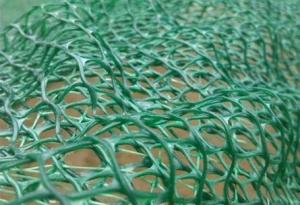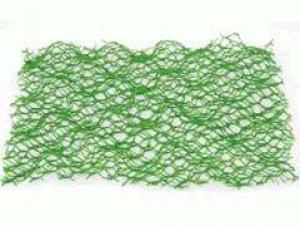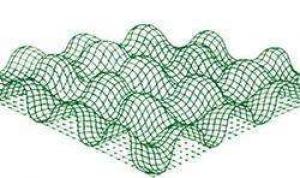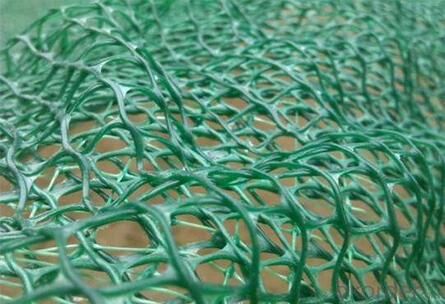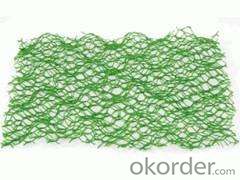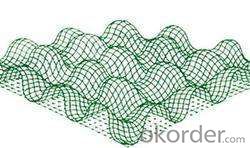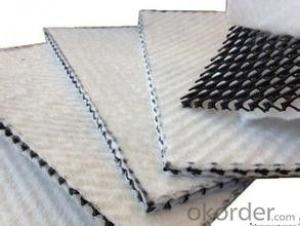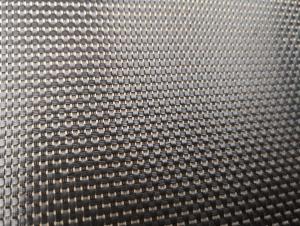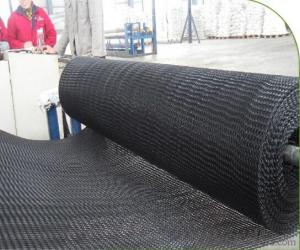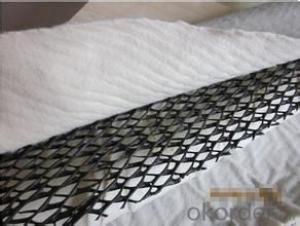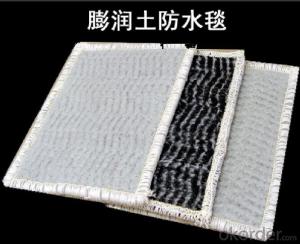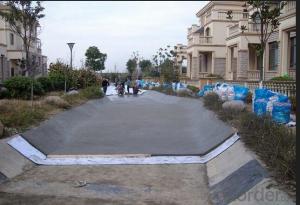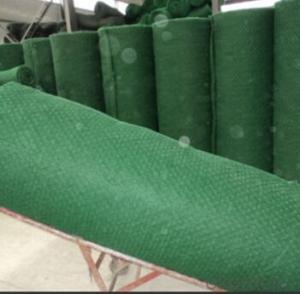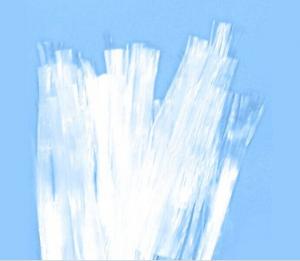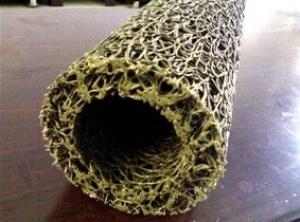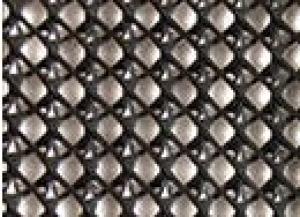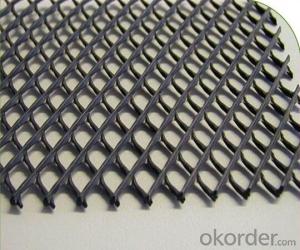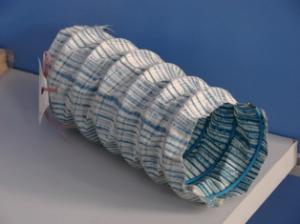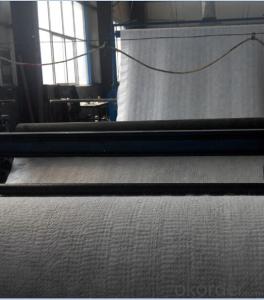3D Geomat for Highway and Railway Embankments
- Loading Port:
- Qingdao
- Payment Terms:
- TT or LC
- Min Order Qty:
- 1000 m²
- Supply Capability:
- 500000 m²/month
OKorder Service Pledge
OKorder Financial Service
You Might Also Like
Description:
CMAX Geomat is a new kind seed planting material with tridimensional structure, which can effectively prevent the soil being washed away, and increase the area of virescence, and improve our environment very well.
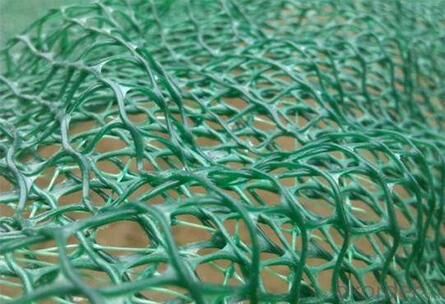
Specification:
Item: EM2, EM3, EM4, EM5
Thickness: 10mm-16mm
Width:2m or as request
Length:50m or as request
Color: green or black color
Property:
1) Before the greensward grows, it prevents the surface of the land from the erosion of the wind and rain.
2) Form compound protection layer with the vegetable, standing the wash-out of the high water level and large speed current.
3) Replace the concrete, asphalt, and block, using in the slope surface protection of roadway, railway, river-way, dyke, and the hillside, etc.
Application:
1) Prevent the surface of ground form weather beaten before the seeds growing up.
2) The compound protection layer will be forming after the grass grow up, which can endure wash by high level and high speed water.
3) It can be a substitute of the concrete, bitumen, stone, and so on to the perfect slop protection material. So it can be widely used in highway, railway, riverway, embankment and so on.
- Q: How do geosynthetic meshes help in slope stabilization?
- Geosynthetic meshes are used in slope stabilization by providing reinforcement and containment of soil or rock materials. They help distribute the forces acting on the slope and increase its overall stability. By preventing soil erosion and promoting better drainage, geosynthetic meshes effectively mitigate the risk of slope failures and landslides.
- Q: How can geocells be used in green roof systems?
- Geocells can be used in green roof systems by providing structural support and stabilization to the growing medium and vegetation. The cells can be filled with soil or other lightweight materials and arranged on the roof surface to create a network of compartments. This helps to distribute the weight evenly and prevent erosion or displacement of the growing medium. Additionally, geocells can aid in stormwater management by retaining water within the cells, promoting plant growth and reducing runoff. Overall, geocells enhance the durability, sustainability, and functionality of green roof systems.
- Q: How are gabion baskets filled and installed?
- Gabion baskets are filled and installed by first assembling the wire mesh baskets at the desired location. Then, stones or other suitable fill materials are placed inside the baskets until they are completely filled. The baskets are typically stacked and interconnected using wire or clips to create a strong and stable structure. Finally, the filled and interconnected gabion baskets are securely anchored to the ground or structure to ensure stability and integrity.
- Q: What are the different types of erosion control blankets available?
- There are several types of erosion control blankets available, including straw blankets, coconut fiber blankets, biodegradable blankets, and synthetic blankets.
- Q: How do earthwork products help with stormwater management?
- Earthwork products such as permeable pavers, geotextiles, and retention ponds play a crucial role in stormwater management. Permeable pavers allow rainwater to infiltrate through the surface, reducing runoff and preventing flooding. Geotextiles provide filtration and erosion control, preventing sediment from entering storm drains and water bodies. Retention ponds collect and store excess stormwater, reducing the risk of flooding and allowing for gradual release into natural water systems. Overall, earthwork products help mitigate the negative impacts of stormwater by promoting infiltration, reducing erosion, and improving water quality.
- Q: What are the different shapes and designs available for earthwork products?
- There are various shapes and designs available for earthwork products, including but not limited to, rectangular, square, circular, triangular, trapezoidal, and irregular shapes. Additionally, earthwork products can be designed with various patterns, such as crisscross, zigzag, interlocking, or textured surfaces. These shapes and designs are tailored to meet specific construction requirements and provide effective erosion control and stability in different environments.
- Q: What are the specific applications of geotextile tubes in earthwork projects?
- Geotextile tubes, also known as geotubes or geotextile containers, have various applications in earthwork projects. They are commonly used for dewatering and containment purposes, such as in shoreline protection, land reclamation, and sediment control. Geotextile tubes can effectively retain and contain sediment, sludge, or other materials while allowing water to drain out. They are also used in erosion control and slope stabilization projects, providing a barrier against soil erosion and reinforcing the stability of slopes. Additionally, geotextile tubes can be utilized for temporary or permanent structures like retaining walls or berms. Overall, their specific applications in earthwork projects contribute to improving site conditions, reducing environmental impact, and enhancing project efficiency.
- Q: How are geosynthetic clay liners used in mining applications?
- Geosynthetic clay liners (GCLs) are used in mining applications as a barrier system to control and contain the movement of liquids and gases in waste containment areas. They are typically installed in the base and walls of mining pits or tailings storage facilities to provide an impermeable layer that prevents the seepage or leakage of harmful substances into the surrounding environment. GCLs offer high hydraulic conductivity and excellent chemical resistance, making them an effective solution for ensuring environmental protection and maintaining the integrity of mining operations.
- Q: How can geotextile bags be used in riverbank protection?
- Geotextile bags can be used in riverbank protection by creating a barrier against erosion. These bags are filled with sand or soil and placed along the riverbank to absorb the energy of flowing water, preventing erosion and stabilizing the soil. The geotextile material allows water to pass through while retaining the soil particles, effectively protecting the riverbank from being washed away.
- Q: How do geosynthetic materials contribute to groundwater protection?
- Geosynthetic materials contribute to groundwater protection by acting as a barrier or filter to prevent contaminants from infiltrating the groundwater system. They are used in various applications such as landfill liners, erosion control, and stormwater management, effectively reducing the risk of pollutants reaching the groundwater. Additionally, geosynthetics help in groundwater recharge by allowing the infiltration of clean water, replenishing the groundwater reserves.
Send your message to us
3D Geomat for Highway and Railway Embankments
- Loading Port:
- Qingdao
- Payment Terms:
- TT or LC
- Min Order Qty:
- 1000 m²
- Supply Capability:
- 500000 m²/month
OKorder Service Pledge
OKorder Financial Service
Similar products
Hot products
Hot Searches
